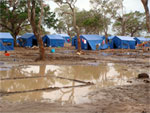Ongoing Difficulties for Returnees and IDPs Still in Camps
by
Internal Displacement Monitoring Centre News Alert, Washington, DC, October 7, 2010
|
However, many returnees reportedly remained displaced in their districts of origin as they found their land occupied by military forces or designated as a High Security Zone. The strong military presence in the return areas had also created insecurity among civilians, especially female-headed households. |
 |
Manik Farm after heavy rain August 2009 |
By the end of August, more than 260,000 people displaced from the north and east since 2008 had returned to their areas of origin, while another 70,000 were staying with host families and almost 35,000 in camps including Menik Farm, according to government figures compiled by the UN.
However, many returnees reportedly remained displaced in their districts of origin as they found their land occupied by military forces or designated as a High Security Zone. The strong military presence in the return areas had also created insecurity among civilians, especially female-headed households.
Returnees also had difficulties rebuilding their livelihoods, as land, streams and wells surrounding their homes in many areas had not yet been cleared of mines. Agencies were lacking funds necessary to speed up the demining process.
In view of the upcoming monsoon season, IDPs in camps as well as returnees urgently needed support to mitigate the anticipated effects of the rains and flooding, including the repair and maintenance of shelters. However, funds were critically short in this area as well.
See also: IDMC Sri Lanka country page
|
 Home
Home Archives
Archives